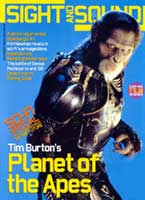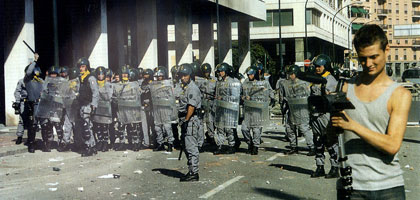
One Deadly Summit

As police fought with anti-globalisation protesters in Genoa last month, a group of radical Italian film-makers set out to get beyond the usual media images of violence. By Patrick Kennedy
In Genoa last month 35 Italian directors gathered to make a documentary about the G8 summit and the protest movement that surrounded it. Ageing radicals took to the streets with digital video cameras, some, like Gillo Pontecorvo - director of Kapo (1960) and The Battle of Algiers (1966), a seminal recreation of the Front de Libération Nationale (FLN)'s struggle for independence from the French in the 50s - overcoming age and illness to do so. 'It is our duty to roll up our sleeves and work with others on such an important occasion, when the quality of life in the future is being decided,' Pontecorvo declared. It turned out to be an exhausting business, and despite the fact that the film had been presold to government-owned channel RAI-3, none of the directors is to be paid.
This isn't the first collective film made under the guidance of co-ordinating director Francesco Maselli. Previous ventures include a tribute following the death of Pasolini and records of the 1984 funeral of Communist Party leader Enrico Berlinguer and 1994's labour strike against the first Berlusconi government. This time the project was put together in just two weeks with limited backing from production company Luna Rosa. The logistics are complicated, with Maselli trying to distribute his colleagues around the city so the protesters' many different voices can be represented. 'The task is so enormous that every night we make a comprehensive schedule for the next day's filming. But no one follows it! We are all proven professionals so we feel free to film where we choose. It would be ridiculous to enforce the plan.'
Arriving in Genoa, I was confounded by the complexity of the city's layout. Its buildings stacked in strata from the waterfront up to the high rock, it seemed like the Tower of Babel smouldering amid the insurrection. As I made my way to the headquarters of Maselli's Il Cinema Italiano a Genoa, I passed the steel barriers set up to cordon off the Red Zone - in which the world leaders and their overblown delegations were assembled - from the critical multitude outside.
Maselli was sitting in an office overlooking the Piazza del Portello where a protest was being staged by travellers, film-makers, monks and musicians. 'These are the pacifists,' he told me. As his cameraman began to shoot the events outside, producer Mauro Berardi explained: 'We have to be careful filming from here. A state of emergency has been declared and we no longer have any laws in the city. The police make it up as they go along.' He then offered to show me the broken remnants of several cameras the police had taken objection to.
Cheers rose up from the crowd outside. Like most of the protests in Genoa, this one had a certain theatricality: framed by the elegant buildings lining the piazza, the protesters toyed with the gleaming ranks of the Carabinieri, decked out in dark blue uniforms, black leather boots and polished plastic accoutrements - the trappings of modern power. Their tanned faces were set with gladiatorial determination or lazy, smirking superiority. If you went too close, you got a whacking.
While I was talking to Maselli news came through of the police shooting of protester Carlo Giuliani. Director Ettore Scola had been there and had filmed the scene. The footage of Giuliani's death has become the defining image of the Genoa G8, but whether it'll form the centrepiece of Maselli's film is still an open question. 'For the last film we made Daniele Segre shot a sequence that contained the most important moment. When we started editing I wouldn't accept it - it was too spectacular - but in the end it became the film's cornerstone: the one moment that linked all our intentions.' Segre, a prominent documentary film-maker who focuses on social issues, cornered me and reiterated his commitment: 'We must use this extraordinary occasion to revitalise Italian cinema from a collaborative perspective, even if to engage in politics damages our prospects of employment.'
Maselli decided to film a press conference down on the waterfront given by the Genoa Social Forum (GSF), the group representing the various protesters. In the absence of any organised transport I was commandeered as chauffeur. When our route was blocked, Maselli, fit for his 70 years and occasionally breaking into song, strolled over broken glass in his slippered feet, seemingly impervious to the surrounding flames. A police van spewed out acrid smoke and his cameraman stopped to film it. But Maselli was right - such shots were a dime a dozen.
At the forum hundreds of people listened as speeches were given and speakers jostled for the microphone. Maselli waded into the crowd to start filming GSF leader Vittorio Agnoletto. There was a mounting sense of danger and agitation and when I returned to headquarters a young man from the production office told me not to venture out again into streets where a young girl had been beaten to death by the police. The truth of his report was never confirmed, but it was a measure of the paranoia that had set in. That the police could do anything in this lawless limbo was confirmed when they later raided the GSF headquarters, hospitalising more than 30 people.
Ignoring the advice, I made my way to the Piazza Gaetano Alimonda, where a collection of flowers, candles and notes covered the sand hastily thrown over Giuliani's blood. A stray cameraman from Il Cinema Italiano arrived. Half an hour away Bob Dylan - whose 'Masters of War' had never seemed more appropriate - was playing a gig, but Scola said he was too shattered to film it. Francesca Comencini had chosen to document a four-day workshop by Living Theatre that culminated with a performance, but mostly the protests themselves were theatre enough for the thousands of amateur and professional cameras.
The proliferation of DV equipment has made protesters more sensitive to the aesthetics of their actions. A peaceful march is no longer likely to force an agenda into the public domain. Ritualised clashes between police and demonstrators, blood, flames and plumes of tear gas - these are the images deemed newsworthy. There was a self-consciousness to the demonstrations at Genoa as each faction fought for the oxygen of publicity. And in a sense Il Cinema Italiano was complicit in the spectacle. Maselli himself was clearly more interested in the intellectual debates and the leaders' speeches, while Scola had spent a day filming in the Red Zone. Pontecorvo claimed to be 'absolutely against the violence', but added: 'You know, sometimes violence helps the masses' visibility. The G8 discussed Africa here - and not because they'd suddenly become good people overnight.' Young Italian actor Ignazio Oliva, working as a cameraman for Comencini, declared he had stopped filming on the frontline in disgust at the tactics employed by anarchist umbrella group the Black Block. 'I don't think Maselli will focus on them anyway,' he said. 'They're fascists, they don't represent the majority.'
The next day, as a peaceful, well-organised demonstration of thousands made its way along the waterfront, attempts were made to disarm those who'd come fortified with sticks. Fierce scuffles would break out within the crowd until the chant of 'Via bastoni! Via bastoni!' (Throw your sticks away!) forced calm. But despite the will of the majority, the demonstration quickly turned into a battleground thanks to the efforts of some 20 protesters, rumoured to be agents provocateurs. Soon buildings were on fire and elderly couples peered over their balconies to see the flames lick the apartments below. The appearance of snipers on the roof created panic and the crowd surged backwards.
Segre was concerned that the many separate agendas were being obscured by the magnitude of the event. 'All the world's media are assembled but there are no cameras to film the misery of factory workers or of families with no money. This lack of visibility is a problem Italian film-makers must address.' The use of location shooting and non-professional actors to portray contemporary events and the struggles of marginalised groups were the hallmarks of the neorealist cinema of such auteurs as Rossellini, Visconti, Zavatini and De Sica in the 40s, and later of the work of Pontecorvo and Scola (Down and Dirty/Brutti, sporchi e cattivi, 1976; A Special Day/Una giornata particolare, 1977). Yet Segre speaks of Ken Loach's films as the best contemporary example of a social cinema that gives 'a voice to the people who do not have one' which he wants to revive in Italy.
Meanwhile Pontecorvo - taking such concerns to their logical conclusion - was trying to persuade his collaborators to enlarge the project to include 'a survey of the health of the world today'. He said most of them agreed with him that two versions of their film should be made: 'One will be produced quickly for the screening on RAI-3 in October. The other must take longer, to include not only Genoa on fire but to relate that footage to the state of the planet.' At 79, Pontecorvo is eager to talk, but the aggravation of his back problems caused by filming from 8am until midnight forced him to return home early to Rome. 'It was one of the worst experiences physically - I was dead! But I was very sorry to have missed the action. When I was young I used to make newsreels - I landed in prison only once and suffered only three bad knocks on the head!'
The directors acknowledge that post-production is where the film will take shape, though Maselli refutes my suggestion that he's the author of the film. 'No, I'm the co-ordinator, though the idea was mine. But the real creativity is in the editing, which will be fascinating and very difficult because we have very different styles. But we had a big discussion about it before filming began.'
Carlo Valerio will work as editor and Ennio Morricone will provide a score. Pontecorvo, who used Morricone on The Battle of Algiers, has said that for him a film never comes alive until he has a sense of the soundtrack. In Algiers the glottal cries of the Algerian women and the baba saleem drumming provide a voice of resistance, disorienting the enemy in the labyrinth of the kasbah. Genoa too has a diegetic soundtrack - the warlike noise of the Carabinieri beating their shields and the spirited drumming of the protesters' response.
Yet it remains for this protest movement to find the tactical discipline of Algeria's FLN as portrayed so vividly in Pontecorvo's film. The solidarity of its organised networks of resistance inspired the Black Panthers in the 70s to use The Battle of Algiers as a tactical case study in urban guerrilla warfare. In Genoa, the theatre of politics pitched a vivid battle. The task for the film-makers will be to lift the events of that week out of the morass of intrigue, accusation and anger and make a film for the world to see.
